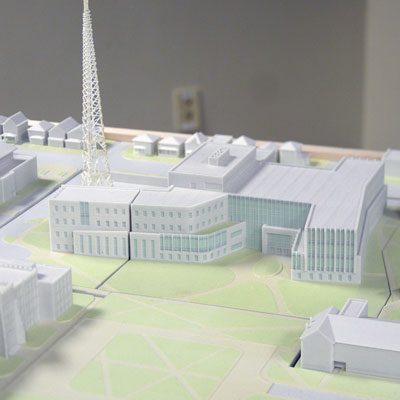The new business and engineering complex promises to be a game changer.
Soon after mortarboards flew in the air at the conclusion of Bradley University’s May commencement, the Hilltop, typically quiet over the summer, became a hub of activity. The green space in front of Baker Hall was transformed into a construction zone as preparations began to dismantle the 61-year-old building that originally served as Lovelace Hall, a dormitory, and later became home to Bradley’s Foster College of Business.
The demolition makes way for Phase 1 of a business and engineering complex that promises to bring new opportunities to Bradley… and to Peoria.
 A Collaborative Experience
A Collaborative Experience
East of the Renaissance Coliseum, the facility’s Main Street entrance reflects the welcoming atmosphere that will be an important aspect of the culture within. Glass enclosures on each end of the building will allow passersby to see students at work in the building; gathering spaces will encourage face-to-face interaction among students, faculty and guests; and a large meeting room will serve both Bradley and the community.
The complex, along with the new Institute for Innovation through Collaboration, should also boost economic development in the area. “We created the Institute so all convergence activities will go through it,” explains Dr. Darrell Radson, dean of the Foster College of Business. “We want companies to be members of the Institute and present projects for our students to work on. We hope these collaborative projects will go beyond our two colleges and involve other disciplines, like game design and computer science.”
Members of the community also will be encouraged to attend makers’ laboratory days, robotics competitions, Legos competitions, joint endeavors with Quest Charter Academy, and other events and learning opportunities at the complex. Bradley students will help run the makers’ laboratory, allowing high school and middle school students to bring in their ideas and create small gadgets with equipment in the facility.
“This will enhance an already strong community-collaborative experience and help many of Peoria’s challenges. [Youth] will see they can study and create a wonderful career, and Bradley wants to be part of that,” notes Dr. Lex Akers, dean of Bradley’s Caterpillar College of Engineering and Technology. “High school students will see others just a few years older than them being successful. They will see wonderful role models, and hopefully, they will want to be educated in Peoria.”
 Breaking Down Silos
Breaking Down Silos
Bringing business and engineering disciplines together in one building—not just physically, but collaboratively—will break down natural silos and offer a strategic advantage to students. “We already have two junior-level courses to help business and engineering students work together on projects,” Akers says. “We will continue those courses and expand from there.”
The complex is expected to be 80-percent complete by late summer 2019, when the two colleges will move into the building. At that point, Jobst Hall, the current engineering building, will be demolished to make way for Phase 2 of the complex, with expected completion during the 2020-21 school year.
“If we want to give students the greatest education, then we need to give them the most opportunities,” adds Radson, discussing the impact the business and engineering complex will bring. “This is a game changer in how we look at each other [across disciplines]. As we work with businesses and they see our commitment, the collaboration will propel us all to new heights.” iBi


